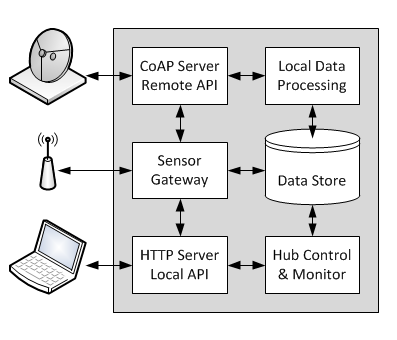Extending The Internet Of Sensors To Remote Locations
Posted : 19-06-2015
In 2014 we were fortunate enough to receive an Innovate UK 'Internet of Sensors' feasibility study grant. This is a brief summary of the project outcomes as presented at a recent KTN Intelligent Sensing Programme event.
In late 2013 the UK Technology Strategy Board (now Innovate UK) launched a funding competition for collaborative feasibility studies into 'Enabling the Internet of Sensors'. This phrase was used to emphasise the fact that many of the embedded devices which are expected to make up the emerging 'Internet of Things' will have some form of sensing as their primary function. In the project proposal, we posed the following question:
'How is it possible to enable the Internet of Sensors in remote, off-grid locations?'
Answering the Challenge
To address this question, we needed to establish a partnership with another innovative small business which had access to appropriate technology for solving the remote access part of the problem. In this case, we were able to work with Silicon Infusion Limited who have an extensive portfolio of high performance wireless technology. This allowed us to focus on the problem of commissioning, maintaining and monitoring low power sensor networks in an 'arms length' manner.
The overall objective of being able to deploy a large number of Internet connected sensors to remote locations raises a number of interesting technical challenges. The primary aim of the feasibility study was to investigate potential solutions to these challenges and demonstrate their practicality through an initial proof of concept system. Since interoperability is a key driver for the Internet of Things, we tried to incorporate existing standards and communication protocols wherever possible.
It was clear from the outset that the only viable technology for accessing remote locations was to use satellite communications. However, modern satellite modems are highly sophisticated devices where the associated cost, complexity and power requirements conflict with the sensor node requirements of low cost, large scale deployment, zero maintenance and independent supply of power. This meant that the logical approach was to investigate the feasibility of sharing a single satellite communications link amongst a large number of locally connected sensor devices.
An 'Arms Length' Approach To The IoT
One of the restrictions imposed by using satellite links to communicate with remote sensor devices is that there are significant constraints on the available bandwidth. This makes it cost prohibitive to back-haul all of the generated sensor data over the satellite link. Under these circumstances, the conventional IoT approach of aggregating the sensor data in a centralised cloud based database is not viable. To address this issue, we demonstrated a proof of concept approach to managing large sensor networks at 'arms length' over the type of bandwidth limited, high latency connections typical of a satellite communications link. A high level view of the software stack which we ported to Silicon Infusion's ARM Linux server board is shown in the following diagram:

This modular design was built on top of the Zynaptic Reaction framework, with the Zynaptic Stash component being used to provide localised sensor data logging. To access the sensor data via the satellite link we implemented a RESTful API using the Constrained Application Protocol (RFC7252) for latency tolerant access and the Concise Binary Object Representation (RFC7049) for efficient data serialisation. This gave us a standards based solution for addressing the low bandwidth and high latency characteristics of the satellite link.
As previously mentioned, for large sensor networks it is not practical to back-haul all of the raw sensor data over a satellite link. This meant that we needed to provide a way of processing the data remotely on the satellite gateway. Since the Linux server board was based on a Freescale iMX6 quad core processor, it provided adequate computing resources to implement a wide range of data analysis algorithms. As different application domains will have different data analysis requirements, a modular approach was adopted. The idea was to allow different data analysis modules to be loaded into the OSGi runtime, with their associated data processing APIs being accessible over the satellite link via the CoAP server.
Within this framework it is possible to implement both online and on-demand data processing capabilities. Online data monitoring processes the incoming sensor data as it is delivered to the satellite gateway, generating 'push' notifications when significant events are detected. On-demand processing allows historic data to be analysed over long time periods, and is initiated by 'pull' requests for specific analysis results. These concepts were demonstrated as a generic proof of concept within the scope of the feasibility study. If you have a specific application which you feel could benefit from this approach, please contact us and we would be happy to discuss ways of adapting it to your requirements.
Presentation Slides From The KTN ISP42 Event
We recently had the opportunity to present the preliminary results of the study
at the
Intelligent Sensing Programme 42 - Internet of Things event organised by the
Sensors and Instrumentation group of the Innovate UK Knowledge Transfer Network.
A copy of the slides presented during the event is available here:
